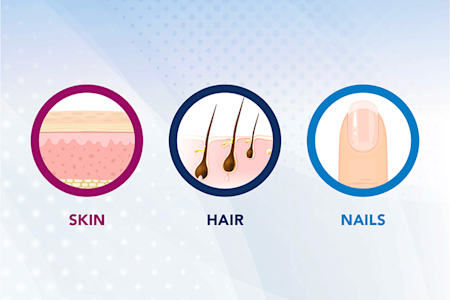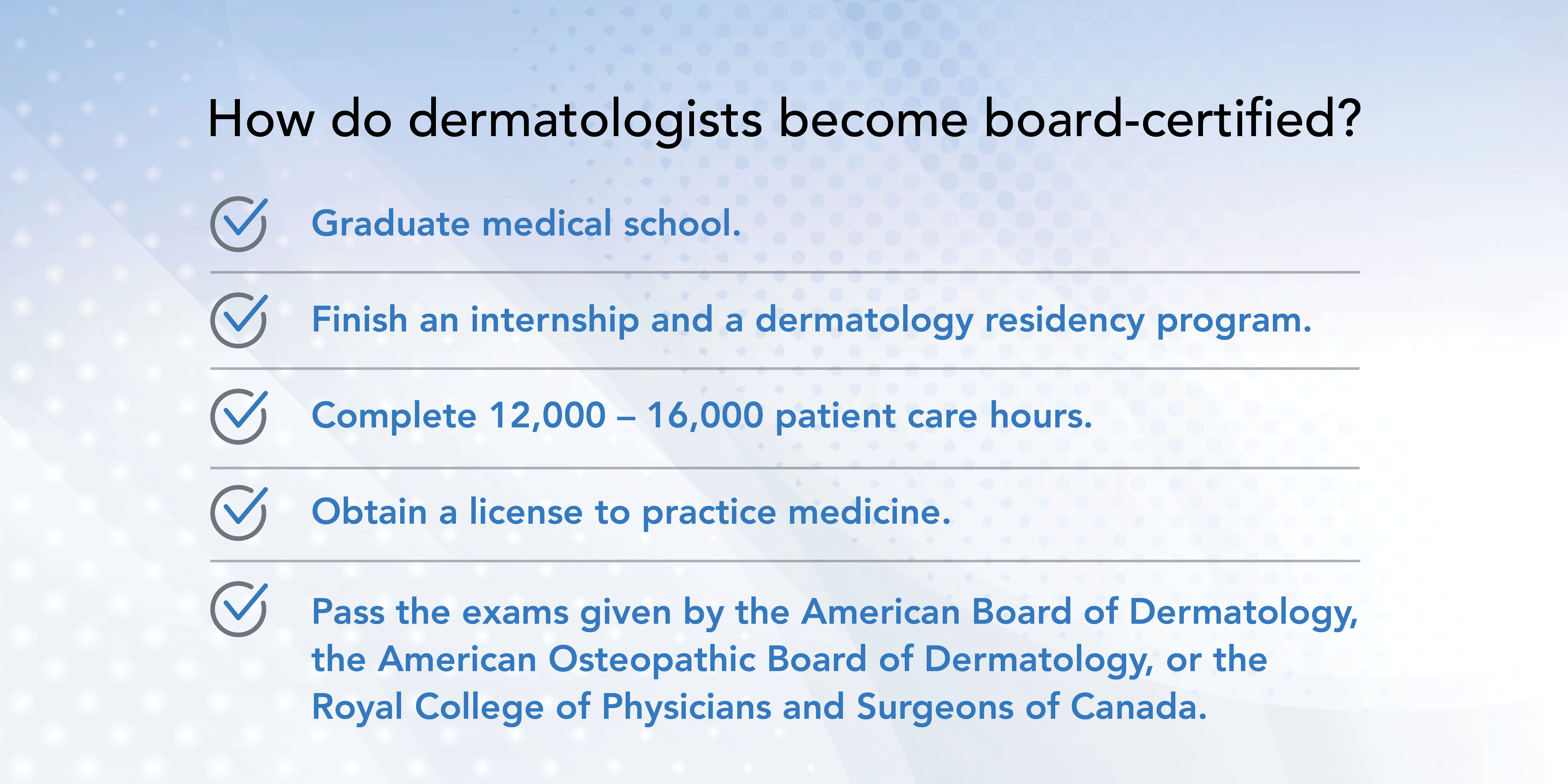What is a dermatologist?
What is a dermatologist?
A dermatologist is a medical doctor who specializes in conditions that affect the skin, hair, and nails. Whether it’s rashes, wrinkles, psoriasis, or melanoma, no one understands your skin, hair, and nails better than a board-certified dermatologist.

The skin is an incredible organ. It is your first line of defense against disease, protects your other organs, warms you up and cools you down, and sends messages about how healthy you are inside. Dermatologists are expert medical doctors and skin surgeons with the unique skills and experience to offer the best care for the organ that cares for you.
What does a dermatologist do?
A board-certified dermatologist has extensive training, which allows them to accurately diagnose and properly treat more than 3,000 diseases of the skin, hair, and nails as well as cosmetic concerns.
If you were to watch a dermatologist at work on any given day, you might see them:
Treat a baby’s prominent birthmark that threatens the child’s eyesight.
Remove a mother’s deadly melanoma at its earliest, most treatable stage.
Offer relief for a student whose chronic eczema makes sleep nearly impossible.
Diagnose the life-threatening liver condition causing a grandfather’s unbearable itching.
Treat the hair loss of a young woman, helping her gain the confidence to search for a job.
Your dermatologist knows the difference between something small and something major.
Dermatologists also understand that a skin condition can have a serious impact on your health and well-being. Sometimes, a skin condition is a sign of a serious underlying health issue, and your dermatologist may be the first one to notice it. For example, signs of diabetes and heart disease can show up on the skin.
Your dermatologist knows that a skin condition doesn’t have to be life-threatening to reduce a person’s quality of life. A skin condition can cause sleep loss, poor self-image, serious depression, or lost productivity. Eczema (aka atopic dermatitis), hair loss that causes scarring, and psoriasis are some conditions that can do this.
Learn more about dermatologists and the life-changing care they provide to their patients.
People of all ages develop conditions that affect their skin, hair, or nails, so dermatologists care for patients of all ages, from newborns to people more than 100 years of age.

Gaining the expertise to provide this level of care takes many years of education.
What training does a dermatologist have?
When it comes to diagnosing and treating conditions that affect the skin, hair, and nails, no one has completed more training than a board-certified dermatologist. Before they can begin practicing, dermatologists receive more than a decade of training, including:
Four years of college to earn a bachelor’s degree
Four years of medical school to become a medical doctor
A year-long internship in medicine
Three years of residency in dermatology, working alongside experienced doctors and completing 12,000 to 16,000 hours of treating patients.

Some dermatologists will then pursue additional advanced training in a particular area. This is known as fellowship training.
What is a board-certified dermatologist?
To become board certified in dermatology requires:
Going to medical school and becoming a doctor
Successfully completing residency training in dermatology
Passing the board exam, a challenging exam that tests the dermatologist on the knowledge and skills acquired during their years of training
Passing the board exam means the dermatologist is board certified. Board certification comes from one of these three organizations:
American Board of Dermatology
American Osteopathic Board of Dermatology
Royal College of Physicians and Surgeons of Canada
When you see that your dermatologist is board certified by one of these organizations, you know you are receiving care from someone who has received the most rigorous education in the field. There are many different kinds of boards, and other certifications do not reflect the same level of training and expertise.

How can I tell if a dermatologist is board certified?
When you see the letters FAAD after their name, you know a dermatologist is board certified. FAAD stands for Fellow of the American Academy of Dermatology.
Why partner with a board-certified dermatologist?
Everyone’s skin is unique. No one understands your skin better than a board-certified dermatologist. When you partner with this expert, you get the best care.
A board-certified dermatologist knows how to accurately diagnose and properly treat a wide variety of skin conditions from deadly skin cancers to warts.
They have expertise in caring for conditions ranging from long-term diseases caused by problems with your immune system and allergic reactions to hair loss and infections caused by bacteria or viruses.
Dermatologists understand the interaction between the skin and the rest of the body. What seems like a simple rash might be a sign of an underlying disease. For example, that itchy rash could be hives, scabies, or a skin reaction called contact dermatitis. Each of these diseases requires different treatment.
When you’re under a dermatologist’s care for a skin condition, your dermatologist can monitor you for other medical conditions. For example, someone living with psoriasis has a greater risk of developing high blood pressure, unhealthy cholesterol levels, and diabetes, so a dermatologist will watch for signs of these conditions.
Dermatologists also help patients who want help with cosmetic concerns like:
Wrinkles
Sagging skin
Scarring caused by acne or surgery to remove a skin cancer
Giving the skin to a healthier appearance after someone develops AIDS
People trust their cosmetic concerns to board-certified dermatologists because dermatologists know the skin as well as the anatomy of the nerves and muscles that lie beneath the skin. This expertise helps them choose the best cosmetic approach for each patient, avoid issues with cosmetic treatments, and correct an issue quickly if it happens.
Another benefit of seeing a dermatologist for a cosmetic concern is to make sure you have a cosmetic concern. For example, what looks like an age spot could be a skin cancer. Removing a skin cancer like you would an age spot can allow the skin cancer to grow and possibly spread.
Does dermatology have specialties?
Yes. After becoming a board-certified dermatologist, some dermatologists continue their medical training. They may receive advanced training within dermatology and become one of the following specialists:
Dermatopathologist
Mohs surgeon
Pediatric dermatologist
The following explains what each of these specialists does and when you might need a dermatologist who specializes in one of these areas.
What is a dermatopathologist?
A dermatopathologist is a doctor who specializes in both dermatology and pathology (the study and diagnosis of diseases).
When your dermatologist sees an issue of concern on your skin, they may remove a small piece of the skin and send it to a dermatopathologist to confirm their suspected diagnosis. This is called a skin biopsy.
Dermatopathologist
A dermatopathologist is a doctor who specializes in both dermatology and pathology. Knowing both fields allows this doctor to diagnose diseases by looking at a bit of removed skin, hair, or nail with a microscope.

The dermatopathologist examines tissue removed during a skin biopsy with a microscope and provides your dermatologist with a written report called a biopsy report or pathology report. This report will tell if you have a disease, and if so, what it is. If a disease is found, it will include other information that can help determine the best possible treatment.
For some conditions, like skin cancer, a skin biopsy is the only way to get an accurate diagnosis and know how deep the cancer lies within the skin.
How does a doctor become a dermatopathologist?
To become a board-certified dermatopathologist, a doctor must first complete training in dermatology — or sometimes in pathology. Once this training is complete, the doctor spends one year developing advanced skills in diagnosing skin disease by examining skin samples under a microscope. This training is needed to pass the board exam in dermatopathology. Only doctors who pass this exam become a board-certified dermatopathologist.
Concerns about your diagnosis?
If you have any concerns about your diagnosis, ask to have a board-certified dermatopathologist look at the tissue taken during your skin biopsy.
What is a Mohs surgeon?
This surgeon specializes in Mohs (pronounced Moes) surgery, a specialized surgery used to treat skin cancer.
What makes Mohs surgery unique is that the surgeon can see where the cancer stops. This isn’t possible with other treatments for skin cancer.
How does a doctor become a Mohs surgeon?
While all dermatologists learn about Mohs surgery during their training, a Mohs surgeon receives the most training in this area. In fact, most Mohs surgeons are dermatologists who have completed additional training, often during a fellowship program. The additional training in Mohs surgery typically takes one year and focuses on Mohs surgery and surgical reconstruction.
Mohs surgeon
A Mohs surgeon is a dermatologist who performs Mohs surgery, a specialized type of surgery used to treat skin cancer.

Mohs surgery has many advantages, but it is not the right treatment for everyone who has skin cancer. A dermatologist considers many factors before determining which treatment will be best for each patient. These factors include the type of skin cancer, whether the cancer has spread, and where the skin cancer appears on the body.
What is a pediatric dermatologist?
A pediatric dermatologist specializes in treating children (newborns to adolescents) with a condition that affects their skin, hair, or nails. While all dermatologists treat children with skin conditions, you may be referred to a pediatric dermatologist if your child is diagnosed with a severe disease, challenging birthmark, or rare condition.
How does a doctor become a pediatric dermatologist?
Like other specialties within dermatology, becoming a pediatric dermatologist requires extra medical training. To become a pediatric dermatologist, a doctor must first become a board-certified dermatologist. Once a dermatologist, the doctor can apply for a fellowship in pediatric dermatology. If accepted into a fellowship program, the dermatologist will complete one or two years of training in pediatric dermatology. After completing this fellowship, the dermatologist must pass the board exam to become a board-certified pediatric dermatologist.
Partnering with a board-certified dermatologist for concerns about your skin, hair, or nails ensures that you’ll receive care from the medical expert in this field.
Pediatric dermatologist
Some diseases that affect the skin, hair, or nails are more common in children, and some of these diseases only occur in children.

Related AAD resources
Images
GettyImages
Last updated: 10/5/22
 Atopic dermatitis: More FDA-approved treatments
Atopic dermatitis: More FDA-approved treatments
 Biosimilars: 14 FAQs
Biosimilars: 14 FAQs
 How to trim your nails
How to trim your nails
 Relieve uncontrollably itchy skin
Relieve uncontrollably itchy skin
 Fade dark spots
Fade dark spots
 Untreatable razor bumps or acne?
Untreatable razor bumps or acne?
 Tattoo removal
Tattoo removal
 Scar treatment
Scar treatment
 Free materials to help raise skin cancer awareness
Free materials to help raise skin cancer awareness
 Dermatologist-approved lesson plans, activities you can use
Dermatologist-approved lesson plans, activities you can use
 Find a Dermatologist
Find a Dermatologist
 What is a dermatologist?
What is a dermatologist?